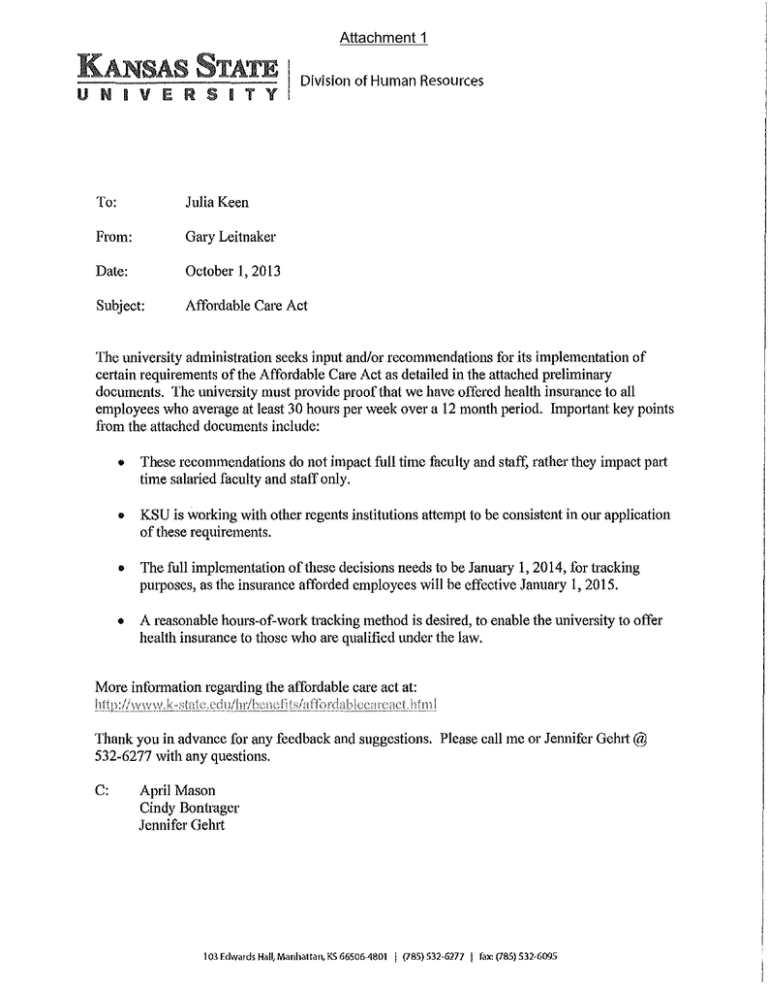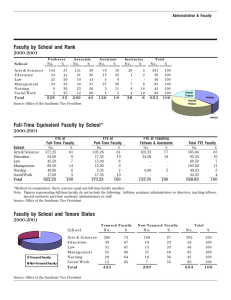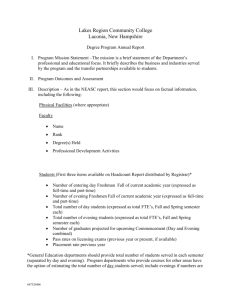KANSAS STATE Attachment 1
advertisement

Attachment 1 KANSAS STATE Division of Human Resources UNIVERSITY To: Julia Keen From: Gary Leitnaker Date: October 1, 2013 Subject: Affordable Care Act The university administration seeks input and/or recommendations for its implementation of certain requirements of the Affordable Care Act as detailed in the attached preliminary documents. The university must provide proof that we have offered health insurance to all employees who average at least 30 hours per week over a 12 month period. Impottant key points fi·om the attached documents include: • These recommendations do not impact full time faculty and staff, rather they impact patt time salaried faculty and staff only. • KSU is working with other regents institutions attempt to be consistent in our application of these requirements. • The full implementation of these decisions needs to be January 1, 2014, for tracking purposes, as the insurance afforded employees will be effective January 1, 2015. • A reasonable hours-of-work tracking method is desired, to enable the university to offer health insurance to those who are qualified under the law. More information regarding the affordable care act at: Thank you in advance for any feedback and suggestions. Please call me or Jennifer Gelut @ 532-6277 with any questions. C: April Mason Cindy Bontrager Jennifer Gelut 103 Edwards Hall, Manhattan. KS 6650&.4801 1 (785) 532-6277 I fax: (785) 532-6095 Attachment 1 Affordable Care Act (ACA) Decision Points Kansas State University October 1, 2013 This document identifies impacts, concerns and preliminary draft solutions to address the employee tracking requirements of the Affordable Care Act at Kansas State University. The university administration is collaborating with other Kansas Board of Regents universities towards consistency in solutions. Background The Patient Protection and Affordable Care Act (PPACA), commonly called Obamacare or the Affordable Care Act (ACA), is a United States federal statute signed into law by President Barack Obama on March 23, 2010. The ACA is aimed at increasing the affordability and rate of health insurance coverage for Americans, and reducing the overall costs of health care (for individuals and the government). It provides a number of mechanisms — including mandates, subsidies, and tax credits — to employers and individuals to increase the coverage rate and health insurance affordability. The ACA requires insurance companies to cover all applicants within new minimum standards, and offer the same rates regardless of pre-existing conditions or gender. A $2,000 per employee penalty will be imposed on employers with more than 50 employees who do not offer health insurance to their full-time workers. "Full-time" is defined as, with respect to any month, an employee who is employed on average at least 30 hours of service per week. To determine who consistently works 30 or more hours per week, a federally required ‘look back’ 12month period has been established by the State of Kansas beginning October 15, 2013 through October 14, 2014. Action Items In order to comply with the ACA, the Division of Human Resources recommends the following actions: 1) Implement a standard course load/work hours conversion for part-time non-tenure track teaching faculty where 12 hours taught per semester equates to full-time status (or some variation thereof.) Graduate Teaching Assistants will teach no more than 6 credit hours per semester to equate to .5 FTE. Effective January 1, 2014. 2) Require all employees in less than .75 FTE non-instructional faculty positions to be nonexempt from overtime to require tracking of actual hours of work in order to monitor the 30hour service requirement for full-time health insurance coverage. This includes Graduate Research Assistants and Graduate Assistants. Effective January 1, 2014. Division of Human Resources Page 1 Attachment 1 Summary of ACA Provisions Effective for Plan Years Beginning in 2014 Determining who is a Full-Time Employee • • • Employers must offer its full-time employees (and their dependents) the opportunity to enroll in minimum essential coverage under an employee health plan or a penalty tax will be assessed Full-time employees are defined as an employee who was employed o on average at least 30 hours of service per week, with respect to any month; or o 130 hours of service in a month Employees paid on a salary basis must have hours of work calculated using one of three methods: o Count actual hours same as for hourly employees; o Use a days-worked equivalency of 8 hours of service per day for each day employee would be required to be credited with a least one hour of service; or o Use a weeks-worked equivalency of 40 hours of service per week for each week the employee would be required to be credited with at least one hour of service. Measurement Period • • • Look-back Measurement Period—the proposed rules define an ongoing employee or new employee as one who has been or will be employed by an employer for at least one standard measurement period. The State of Kansas is determining the full-time status of an ongoing employee by using a measurement period of 12 consecutive months to determine if an employee averaged at least 30 hours of service per week. When employees are rehired within 26 weeks after termination they are not considered new employees; however, the employee may be treated as a new hire if the break in service is longer than the preceding employment length. Proposed rule allows for a margin of error where the employer will be treated in compliance for a calendar month if it offers coverage to 95% of its full-time employees. Issues/Policies for Consideration 1) Adjunct/Part-time Faculty The Division of Human Resources recommends adopting a standard course load for non-tenured or non-tenured track teaching faculty where 12 credit hours per semester is considered full-time. See Appendix A for further detail. The ACA provides for special regulations regarding adjunct/part-time faculty. • • The term “Adjunct” as used in the Affordable Care Act means the faculty member is paid by the number of courses taught, not by the number of hours or effort expected. Faculty teaching only DCE courses is a good example of an “adjunct” under this definition. The law says it is not a reasonable method of crediting hours to only count an adjunct (parttime) faculty member’s classroom or other instruction time, and not count class preparation time that is necessary to perform the employee’s duties. Division of Human Resources Page 2 Attachment 1 • KBOR General Counsel and the State of Kansas have endorsed the American Council on Education (ACE) comments made in a Notice of Proposed Rulemaking to allow educational institutions to use one of two alternatives for determining hours of work: o Part-time faculty should be classified as full-time employees if the course load they teach meets or exceeds three-quarters of the course load for a full-time, non-tenuretrack teaching faculty member in that academic department; or o Credit adjunct faculty members with one hour of work outside the classroom for each hour teaching in the classroom. 2) Salaried Part-time Non-Teaching Faculty/Unclassified Employees Current policy requires unclassified employees hired .5 FTE or greater for more than 90 days to be eligible for health insurance. KSU does not track hours worked for salaried faculty/unclassified employees. Determining hours worked may only be done in the three methods mentioned on page two of this document. HR recommends that all non-teaching faculty, unclassified staff, graduate research assistants and graduate assistants hired less than .75 FTE be considered non-exempt and report actual hours worked. Issues: • • • Currently, there is no confirmation that the assigned FTE equates to the actual hours worked Someone may be appointed for .7 FTE for an entire year but we do not know if the employee is averaging 30 hours or more per week and although they are afforded health insurance, it is at the part-time reduced employer/increased employee rate rather than the full-time rate KSU has about 70 salaried benefits eligible employees who now receive part-time health insurance; if hours are tracked or a course load/work load equivalency is used and they do average 30 hours or more per week, would then qualify for full-time health insurance employer contribution rather than the reduced part-time employer contribution Division of Human Resources Page 3 Attachment 1 Appendix A Full-Time Academic Workload Defined Non-Tenured/Non-Tenure Track Teaching Faculty This policy applies to non-tenured and non-tenure track faculty whose sole responsibility is teaching in a non-clinical environment, and who are not assigned any duties related to research, scholarship, creative activity, and/or service. Credit Load and Equivalent Full-Time Equivalent (FTE): FTE for faculty who meet the above definition. Credit Hours Taught 15 14 13 12 11 10 9 8 7 6 5 4 3 2 1 Option A FTE 1.00 .90 .85 .80 .75 .65 .60 .55 .45 .40 .35 .25 .20 .15 .10 Option B FTE 1.00 1.00 1.00 1.00 .90 .85 .75 .65 .60 .50 .40 .35 .25 .15 .10 NOTE: Universities (and colleges within) differ on amount of work effort regularly required for teaching per credit hour. Option A assumes approximately 2.5 hours effort per week per credit hour Option B assumes approximately 3.3 hours effort per week per credit hour Citations Supporting Option B (12 Credit Hours) Iowa State considers 12 credit hours per semester a full-time teaching load for lecturers. K-State Salina Economics Instructor Ad said the normal teaching load is 12 hours per semester. Pittsburg State appears to have a 12 credit hour course load (as listed on several vacancies) The standard teaching load at Wichita State is 12 credit hours for non-tenure track instructors The University of Texas uses 12 credit hours for full-time non-tenure track faculty. TCU full-time instructors have a 12 credit hour standard per semester A full-time undergraduate student at KSU must be enrolled in 12 credit hours Citations Supporting Option A (15 Credit Hours) Washington State University considers 15 credit hours per semester a full-time teaching load for the above defined employee. At least one community college has capped adjunct teaching load to 10 credits per semester with a limit of 25 hours/week—that equates to the Option A scenario of 2.5 hours effort per course hour. Division of Human Resources Page 4


![MATH Appendix F1: Full-Time Faculty/Adjunct Staffing Request(s) [Acct. Category 1000]](http://s2.studylib.net/store/data/011516099_1-a4f22b1b095e4eb6c40e8a30a8ffd37e-300x300.png)